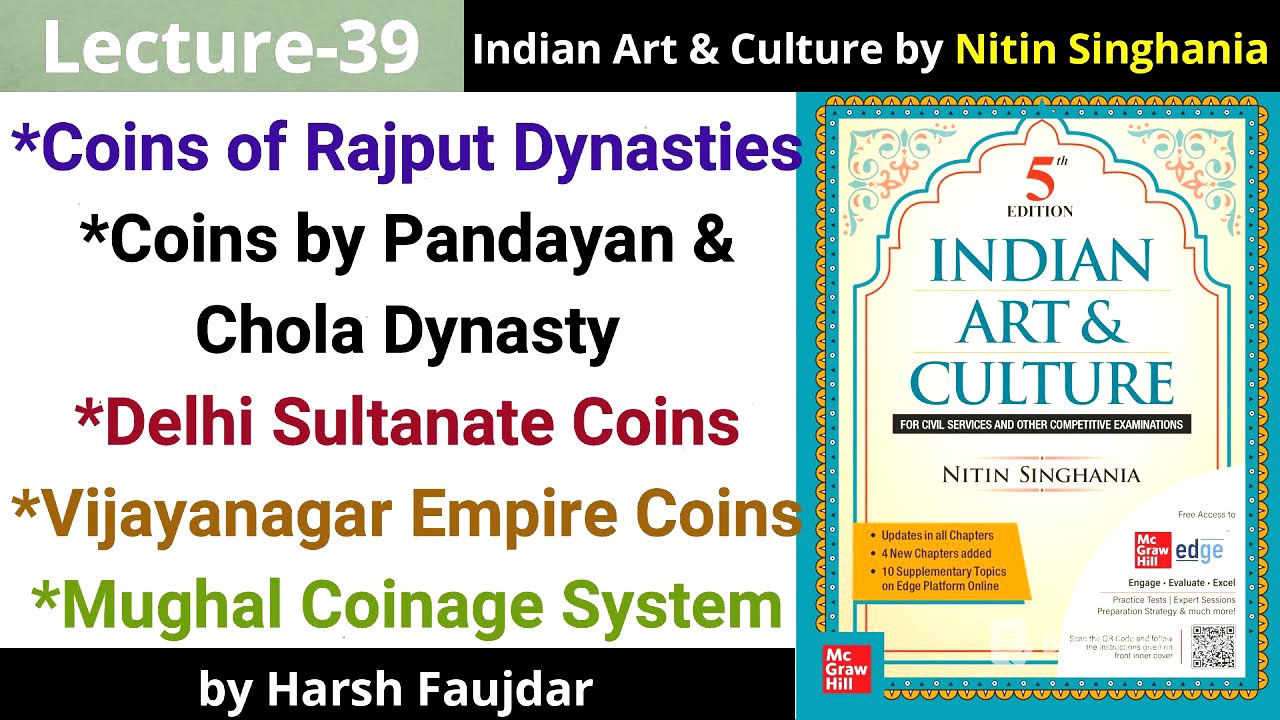TLDR;
This video concludes a discussion on coins in ancient and medieval India, covering the coin systems of Rajput dynasties, Pandyan and Chola dynasties, Turkish and Delhi Sultanate, Vijayanagara Empire, and the Mughal Empire. Key takeaways include the types of coins issued by each dynasty, important coin terminology, and the cultural and economic significance of coinage during these periods.
- Rajput dynasties primarily issued gold coins, with two main coining systems.
- Pandyan and Chola coins featured square shapes initially, with the fish becoming an important symbol.
- Turkish and Delhi Sultanate coins included the king's name, title, and date, but not the king's image.
- Vijayanagara Empire was known for issuing a large number of gold coins with different denominations.
- Mughal coinage system included standard gold coins called Mohur and the silver rupee popularized by Sher Shah Suri.
Rajput Dynasty Coins [0:35]
Rajput dynasties, mainly in present-day Rajasthan, predominantly issued gold coins, along with copper and billon coins (alloy of silver and copper). Silver coins were rare. Two coining systems existed: one featuring the king's name in Sanskrit and an image of a goddess, issued by dynasties like the Chandelas, Tomars, and Rathods; and another involving silver coins with a seated bull on one side and a horseman on the other, issued by the kings of Gandhara and Sindh.
Pandyan and Chola Dynasty Coins [3:39]
Early Pandyan kings issued square-shaped coins initially featuring an elephant, but later the fish became an important symbol. Gold and silver coins had Sanskrit inscriptions, while copper coins had Tamil inscriptions. Chola King Raja Raja Van's coins displayed the king's image and a goddess, with Sanskrit inscriptions. Rajendra's coins featured "Shri Rajendra" or "Gangai Konda Chola" and the emblem of a tiger and fish. Pallava Dynasty coins had the image of a lion.
Turkish and Delhi Sultanate Coins [6:44]
Coins from the Delhi Sultanate featured the king's name, title, and date according to the Hijri calendar, but not the king's image due to Islamic prohibitions. The mint name was also included on the coins. Iltutmish issued silver coins called Tanka and copper coins called Jethal. Alauddin Khilji removed the Caliph's name from the coins. Muhammad bin Tughlaq introduced bronze and copper coins, which failed. Sher Shah Suri introduced silver coins of 178 grains, later called Rupi, and copper coins of 330 grains, later called Daam. Kandhari Dhiram was an Islamic coin issued by the Aamirs of Sindh, while Muhammad bin Sam issued gold coins with the image of Goddess Lakshmi.
Vijayanagar Empire Coins [14:03]
The Vijayanagara Empire issued a large number of gold coins. The highest denomination coin was the Fagoda, featuring a running warrior with a dagger. Smaller units included Funams (gold), Tars (silver), and copper coins for daily transactions. Coins were produced in different mints and named accordingly, with inscriptions in Sanskrit and Kannada. Krishnadeva Raya issued Gold Varhan coins with Vishnu on one side and "Shri Pratap Krishna Rai" in Sanskrit on the other. Earlier coins were inspired by Hoshiyala coins, and there was a separate department for minting coins. Travancore State used Fanam and Chukram as currency units, with one Fanam equal to four Chukrams.
Mughal Coinage System [19:24]
Standard gold coins issued by the Mughals were called Mohur, weighing approximately 172 to 175 grains. Sher Shah Suri's silver rupee became famous during the Mughal era, and Mughal copper coins were adopted from Sher Shah's denomination. Akbar issued round and square-shaped coins, including the Ilahi coin in 1579 to propagate Deen-e-Ilahi. Jahangir's coins featured couplet legends and the name of his wife, Noor Jahan, with some coins also displaying the Zodiac sign.
Important Facts [23:19]
The earliest reference to coins in India is found in the Vedas, with metal coins termed Nishka. Sher Shah Suri introduced the silver Rupee. Money trees were used to store coins in ancient India. Gupta era coins featured the king's name and title with Aditya. Chhatrapati Shivaji Maharaj issued Gold Huns and Copper Shiv Rise with titles in Nagari script. The Coinage Act of 2011 replaced the Coinage Act of 1906, defining coins and penalties for forgery.


![[자막뉴스] "수능 끝나고 사촌오빠가 저를.."강간범 몰린 남성의 '알리바이' (2023.12.31/MBC뉴스)](https://wm-img.halpindev.com/p-briefread_c-10_b-10/urlb/aHR0cDovL2ltZy55b3V0dWJlLmNvbS92aS9MekxRNm1jOHZVby9ocWRlZmF1bHQuanBn.jpg)



![[Digimon Podcast] LiT Episode 29 - Where's Wallace?](https://wm-img.halpindev.com/p-briefread_c-10_b-10/urlb/aHR0cDovL2ltZy55b3V0dWJlLmNvbS92aS9JdXpiOWNXX0VKQS9ocWRlZmF1bHQuanBn.jpg)


